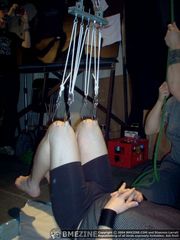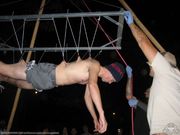Deep Hood and Dynamic Rigging: Difference between pages
(Page conversion via llm-mediawiki-rev -jwm) |
(Page conversion via llm-mediawiki-rev -jwm) |
||
| Line 1: | Line 1: | ||
[[File: | [[File:Suspensionrig1.jpg|thumb|180px|right|Traditional suspension rig]] | ||
[[File:Suspensionrig2.jpg|thumb|180px|right|Newer rig design]] | |||
[[File:Suspensionrig3.jpg|thumb|180px|right|'Box' type rig used for horizontal suspensions]] | |||
'' | The term '''suspension rig''' usually refers to the frame that sits between the [[flesh hooks]] and the rope system in a [[Category:Suspensions|suspension]]. It may also refer to the [[suspension tower]] and complete suspension apparatus depending on how it is being used. | ||
== Contents == | |||
# [[#Ropes and Webbing|Ropes and Webbing]] | |||
# [[#Pulleys and Hoists|Pulleys and Hoists]] | |||
# [[#Bars|Bars]] | |||
# [[#Setting up the Rig|Setting up the Rig]] | |||
# [[#Dynamic Rigging|Dynamic Rigging]] | |||
# [[#See Also|See Also]] | |||
== Ropes and Webbing == | |||
There are many different types of rope, webbing, chain and cable that can be used for suspension. In general, most suspension groups work with the same materials that are used by climbers and professional riggers. The most common of these are nylon webbing (for attaching to support structures), rappelling rope (for connecting support structures to suspension frames) and parachute line (to connect the body to the suspension frame). | |||
== Pulleys and Hoists == | |||
The two most common lifting mechanisms are "[[block and tackle]]" and "[[chain hoists]]." Block and tackle pulley systems have the advantage of being lightweight and are quick for lifting and lowering. The only drawback is that they require a physical point to secure the rope's end. These days, chain hoists are becoming more and more popular due to their self locking system that handles enormous amounts of weight. | |||
== Bars == | |||
Horizontal suspensions are normally done from a rectangular cube with multiple eye-bolts facing downwards on the long sides of the frame and four eye-bolts facing up in the corners. A single long bar design can be used as well for horizontal suspensions. Vertical suspensions are normally one from a single beam with five eye-bolts facing down and two eye-bolts facing up. | |||
== Setting up the Rig == | |||
The easiest way to set up a rig is to first connect one rope to a solid structure (such as a ceiling beam or a tree branch). To that, connect the suspension frame/rig at height where the suspendee will be off the ground, but is low enough that they can step off a chair or a table beneath them can be lowered. When the suspension is over, they step back onto the chair. | |||
== Dynamic Rigging == | |||
Dynamic Rigging in terms of suspensions refers to rigging several different anchor points with the use of only one rope. Dynamic rigging offers an advantage in suspension in that it minimizes the amount of knots needed and allows weight distribution to be adjusted throughout the suspension to either equally distribute weight or focus/remove weight from certain [[flesh hooks]]. Due to the nature of dynamic rigging it also removes the need to spend time tying multiple lines at exact lengths. | |||
== See Also == | == See Also == | ||
* [[ | * [[Suspension]] | ||
* [[Category:Suspensions]] | |||
* [[Category:Suspension Groups]] | |||
Latest revision as of 02:42, 17 September 2023
The term suspension rig usually refers to the frame that sits between the flesh hooks and the rope system in a. It may also refer to the suspension tower and complete suspension apparatus depending on how it is being used.
Contents
Ropes and Webbing
There are many different types of rope, webbing, chain and cable that can be used for suspension. In general, most suspension groups work with the same materials that are used by climbers and professional riggers. The most common of these are nylon webbing (for attaching to support structures), rappelling rope (for connecting support structures to suspension frames) and parachute line (to connect the body to the suspension frame).
Pulleys and Hoists
The two most common lifting mechanisms are "block and tackle" and "chain hoists." Block and tackle pulley systems have the advantage of being lightweight and are quick for lifting and lowering. The only drawback is that they require a physical point to secure the rope's end. These days, chain hoists are becoming more and more popular due to their self locking system that handles enormous amounts of weight.
Bars
Horizontal suspensions are normally done from a rectangular cube with multiple eye-bolts facing downwards on the long sides of the frame and four eye-bolts facing up in the corners. A single long bar design can be used as well for horizontal suspensions. Vertical suspensions are normally one from a single beam with five eye-bolts facing down and two eye-bolts facing up.
Setting up the Rig
The easiest way to set up a rig is to first connect one rope to a solid structure (such as a ceiling beam or a tree branch). To that, connect the suspension frame/rig at height where the suspendee will be off the ground, but is low enough that they can step off a chair or a table beneath them can be lowered. When the suspension is over, they step back onto the chair.
Dynamic Rigging
Dynamic Rigging in terms of suspensions refers to rigging several different anchor points with the use of only one rope. Dynamic rigging offers an advantage in suspension in that it minimizes the amount of knots needed and allows weight distribution to be adjusted throughout the suspension to either equally distribute weight or focus/remove weight from certain flesh hooks. Due to the nature of dynamic rigging it also removes the need to spend time tying multiple lines at exact lengths.


